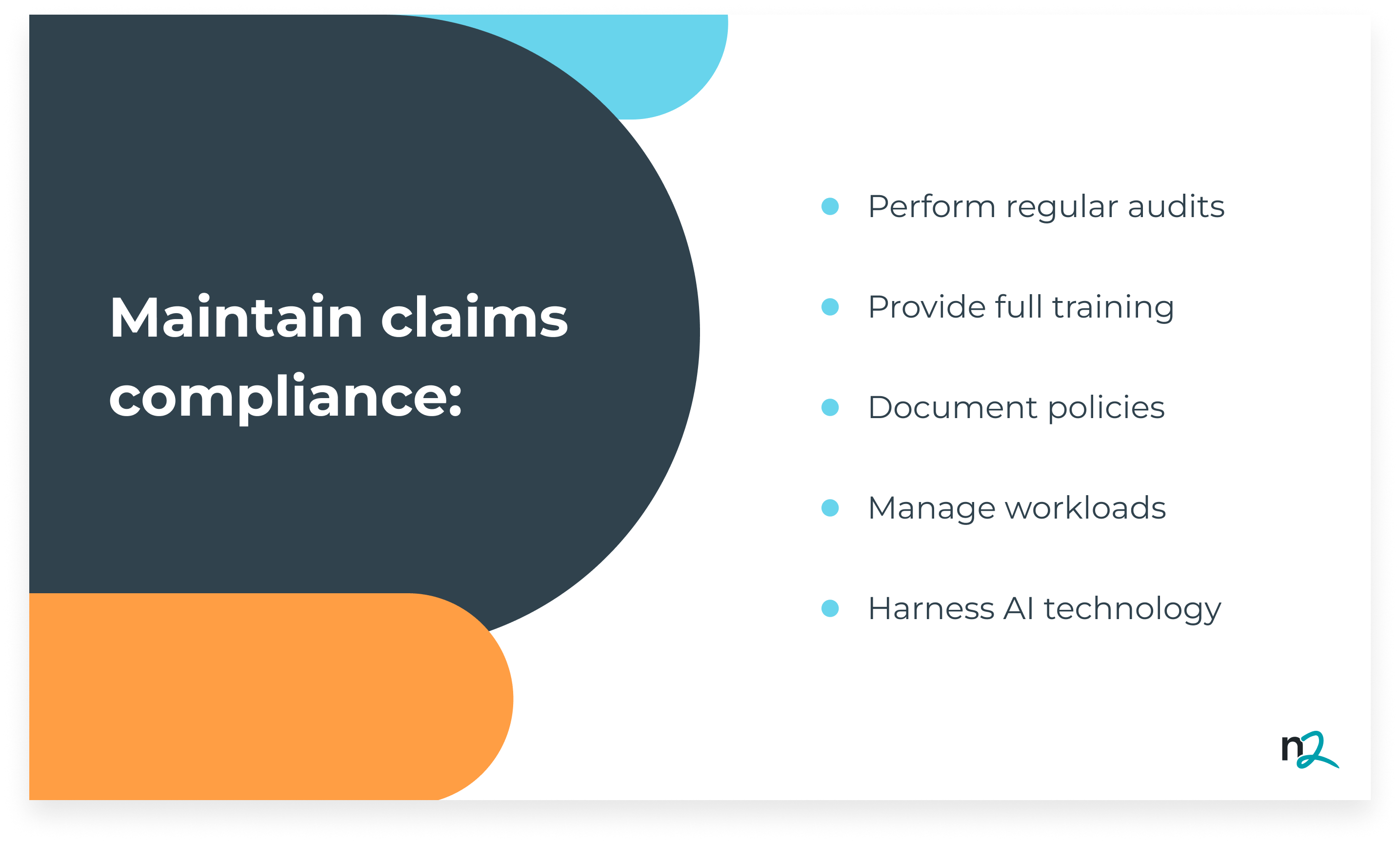Compliance is tough. Ensuring that you are correctly following federal and state laws, possibly even international laws can be a minefield. So much so that Gartner stated that only 13% of legal and compliance leaders feel confident that they can manage cross-functional risks without creating a drag on the business. Let’s improve that confidence by examining the challenges in insurance claims compliance and our top 5 best practices.
5 Major Challenges in Insurance Claims Compliance
1 - Regulatory Changes
Keeping up with continuous adjustments to regulations at an international, federal, and state level is an ongoing challenge. Regulations can impact your claims processing, and require you to update your claims touch points.
2 - Data Privacy and Security Concerns
It’s also important that you are going above and beyond to protect your customers’ data. Insurance companies handle extremely delicate information, that must be protected. If data is hacked or leaked, it can have a hugely negative impact on your company’s reputation.
3 - Fraud Detection and Prevention
Approximately 20% of insurance claims are fraudulent. It’s key that companies identify these claims as quickly as possible not to waste time processing them, or spend money paying for fraudulent claims. AI can help you to detect fraud in an automated way.
4 - Documentation, Storing, and Reporting
Keeping clear, well-organized, accurate records of claims, and storing all forms, reports, and information is important for internal and external audits. Using a cloud-based system can improve security and reduce siloed information.
5 - Third-Party Vendor Risks
Working with third-party vendors is becoming increasingly common, especially to outsource claims handling. It is a good way to manage a high number of claims, but it does open your business up to more risks. These include poor data encryption and management, weak access control (anyone being able to access the information), delayed claim processing, and jurisdictional risks.
Ensuring you perform due diligence, continuous assessment, and have a clear exit plan will help manage your vendors and mitigate risks.
5 Best Practices for Maintaining Insurance Claims Compliance

1 - Regular Compliance Audits
Doing regular internal compliance audits helps you on two counts. The first is that you can proactively find areas of your business that aren’t compliant and fix them. The second is that you need to be prepared for external audits by regulatory authorities. Doing internal audits makes a big difference to ensuring that all your documentation is well-organized and accurate and there is a paper trail of your compliance measures.
2 - Comprehensive Employee Training
Having a compliance officer responsible for training sessions with the rest of your staff ensures that you have someone responsible in charge. The compliance officer can go through new regulations and remind employees of other laws and internal processes. During training sessions, you could also provide small rewards and incentives to make the training more interactive and engaging.
Having clear processes that align with regulatory requirements helps everyone to follow them. If you can automate those processes with software you reduce the likelihood of errors.
3 - Well-Documented Internal Policies
It’s important to have a living document with your internal compliance policies clearly laid out. A living document means that it needs to be updated regularly and consistently. It will help you with training new employees, reminding others of the processes, and ensuring that everyone knows what your policies are. It can also serve as evidence for regulatory bodies of what your compliance processes are.
4 - Optimizing Insurance Adjusters Workloads
By managing insurance adjusters’ workloads, you provide them with time and the space to complete compliance procedures correctly. The busier your adjusters are, the less time they will have to spend on compliance processes, increasing errors and inaccuracies. By managing their workloads you promote a culture of compliance. Employees will have time to investigate any issues, and there needs to be a positive reception when they report any issues.
5 - Utilizing AI & Technology for Compliance
As mentioned above, software can help to automate compliance processes to ensure that they’re completed to reduce the likelihood of human error. Using AI-powered technology you can improve:
- Data management: AI can flag potential issues and discrepancies in your documentation.
- Real-time monitoring: Use AI software to automatically monitor activities and detect issues instantly.
- Real-time reports: Create complete reports quickly, easily, and accurately with AI.
- Detect fraud: Predictive analytics can flag potential fraud automatically, notifying adjusters who can investigate in-depth.
How n2uitive Supports Insurance Adjusters with Claims Compliance
Working with a software company that focuses on secure, simple, effective workflows can improve your compliance and your efficiency. With n2uitive, you have a partner that simplifies and manages the full recorded statement lifecycle.
All-In-One Recorded Statement Management Platform
n2uitive’s innovative solution empowers you to record statements from wherever you are. From your desk, you can use the conference line that automatically records the call and saves it to the cloud. If you’re in the field, use the n2record iOS app to capture the full statement and sync it to our secure cloud-based platform.
From that platform, you can organize your statements, sync them automatically with Guidewire, request a transcription, and share statements securely.
.webp?width=1600&height=700&name=n2uitive%20demo%20trial%20(2).webp)
Trust Assurance Platform for Compliance and Security
At n2uitive, we take data security seriously. We use TrustCloud to ensure full compliance with data security legislation. We’re SOC 2 Type I and II verified and audited, showing that all data on our platform is secure and private. We are constantly monitoring and adjusting our policies to ensure that we remain as secure as possible.
We also simplify and enhance security with SSO login to authenticate users and manage access control.
Insurance Adjusters using n2uitive are 30% More Productive
Using n2uitive you reduce total costs of ownership, increase productivity and job satisfaction across your employees. We work to ensure data security compliance so that you can focus on managing your claims simply.
Book your free demo to find out more.
.webp?width=1600&height=700&name=n2uitive%20demo%20trial%20(1).webp)